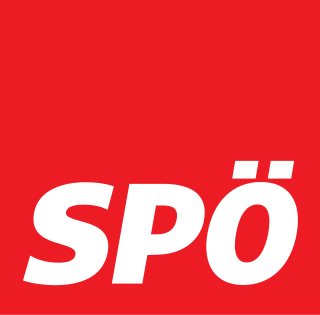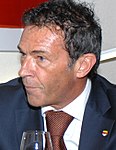
The politics of Austria take place in the framework of the federal parliamentary republic of Austria, with a President as head of state, and a Chancellor as the head of government. Governments, both local and federal, exercise executive power. Federal legislative power is vested both in the Federal Government and in the two chambers of Parliament; the National Council and the Federal Council. The Judiciary of Austria is independent of the executive and the legislature.

Wolfgang Schüssel is an Austrian People's Party politician. He was Chancellor of Austria for two consecutive terms from February 2000 to January 2007. While being recognised as a rare example of an active reformer in contemporary Austrian politics, his governments were also highly controversial from the beginning, starting with the fact that he formed a coalition government with Jörg Haider's Freedom Party of Austria (FPÖ) on both occasions. In 2011, he retired from being an active member of parliament due to a multitude of charges of corruption against members of his governments.
Parliamentary elections were held in Serbia on 28 December 2003 to elect members of the National Assembly. Serbia was one of the two federal units of Serbia and Montenegro, formerly known as the Federal Republic of Yugoslavia.

Early parliamentary elections were held in Austria on 24 November 2002, after internal divisions in the Freedom Party of Austria (FPÖ) culminating in the Knittelfeld Putsch led to the resignation of several leading FPÖ members. The result was a victory for the ÖVP, which won 79 of the 183 seats, the first time it had been the largest party in the National Council since 1966. It continued its coalition government with the FPÖ, which had lost almost two-thirds of its seats. Voter turnout was 84.3%.

Parliamentary elections were held in Austria on 3 October 1999.

Early parliamentary elections were held in Austria on 17 December 1995, after the Grand Coalition between the Social Democratic Party (SPÖ) and Austrian People's Party collapsed over disagreements about the budget. The SPÖ remained the largest party in the National Council and the Grand Coalition was reformed. Voter turnout was 86.0%.

Parliamentary elections were held in Austria on 9 October 1994. The Social Democratic Party won the most seats, and retained the grand coalition with the Austrian People's Party. Voter turnout was 81.9%.

Parliamentary elections were held in Austria on 7 October 1990. The Social Democratic Party won the most seats, and retained the grand coalition with the Austrian People's Party. Voter turnout was 86.1%.

Parliamentary elections were held in Austria on 24 April 1983. The result was a victory for the Socialist Party, which won 90 of the 183 seats. However, the Socialists lost the outright majority they had held since 1971, prompting Bruno Kreisky to stand down as SPÖ leader and Chancellor in favour of Fred Sinowatz. The SPÖ stayed in office by entering into a coalition government with the Freedom Party of Austria, which at this point was a liberal party. Voter turnout was 92.6%.

Parliamentary elections were held in Austria on 6 March 1966. The result was a victory for the Austrian People's Party (ÖVP), which won 85 of the 165 seats. Voter turnout was 93.8%. With an outright majority of three seats, the ÖVP could govern alone. Nonetheless, ÖVP leader and Chancellor Josef Klaus initially sought to continue the grand coalition with the Social Democratic Party of Austria (SPÖ) that had governed since 1945. When talks for a renewed coalition failed, Klaus formed an exclusively ÖVP cabinet, the first one-party government of the Second Republic. It was also the first purely centre-right government in Austria since before World War II.

Parliamentary elections were held in Austria on 18 November 1962. The result was a victory for the Austrian People's Party, which won 81 of the 165 seats. Voter turnout was 93.8%. Although the People's Party had come up only two seats short of an outright majority, Chancellor Alfons Gorbach retained the grand coalition with the Socialists under Vice-Chancellor Bruno Pittermann.

Parliamentary elections were held in Austria on 10 May 1959. Although the Social Democratic Party received the most votes, the Austrian People's Party retained a bare one-seat plurality. The Communist Party of Austria lost its remaining three seats and has not returned to the National Council since. Voter turnout was 94.2%. The grand coalition that had governed the country since 1945 remained in office, with People's Party leader Julius Raab as Chancellor and Socialist leader Bruno Pittermann as Vice-Chancellor.

Parliamentary elections were held in Austria on 13 May 1956. The result was a victory for the Austrian People's Party, which won 82 of the 165 seats in the National Council. Voter turnout was 96.0%. Although the ÖVP had come up one seat short of an absolute majority, ÖVP leader and Chancellor Julius Raab retained the grand coalition with the Socialists, with the SPÖ leader Adolf Schärf as Vice-Chancellor.

Snap legislative elections were held in Austria on 28 September 2008 to elect the 183 members of the National Council. The elections were caused by the withdrawal of the Austrian People's Party (ÖVP) from the governing grand coalition with the Social Democratic Party on 7 July 2008. Due to dissatisfaction with the grand coalition and the two main parties, it was widely expected to be a realigning election, with gains for the opposition and up to seven parties were expected to win seats.

The Freedom Party of Austria is a right-wing populist and national-conservative political party in Austria. The party, led by Heinz-Christian Strache, is a member of the Europe of Nations and Freedom group in the European Parliament, as well as of the Movement for a Europe of Nations and Freedom.

Parliamentary elections were held in Austria on 24 April 1927. The result was a victory for the Unity List (Einheitsliste), an alliance of the Christian Social Party and the Greater German People's Party, which won 85 of the 165 seats. However this brief coalition failed to result in any larger proportion of the votes than when the CSP ran alone, losing votes to the Landbund. Voter turnout was 89.3%.

Legislative elections were held in Austria on 29 September 2013.



















